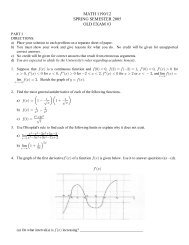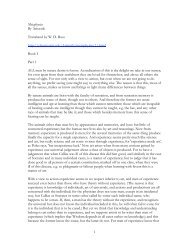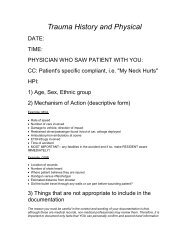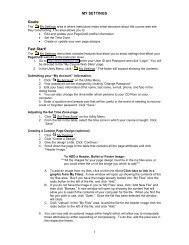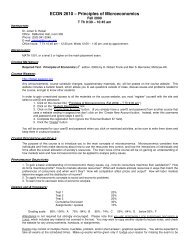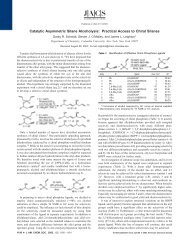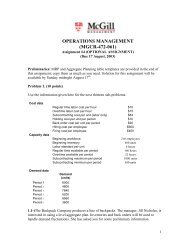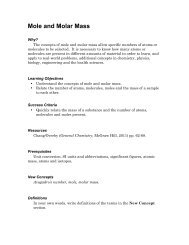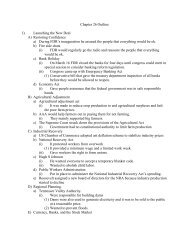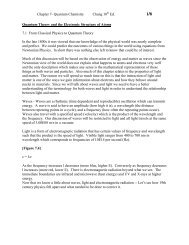MICROBIOLOGY - PageOut
MICROBIOLOGY - PageOut
MICROBIOLOGY - PageOut
You also want an ePaper? Increase the reach of your titles
YUMPU automatically turns print PDFs into web optimized ePapers that Google loves.
<strong>MICROBIOLOGY</strong>LABORATORY PROCEDURES MANUALSmallpox“A sickness that no medicine could cure, and no person could escape”-- Simon Pierre, 1959Jerry W. Hicks
TABLE OF CONTENTSExercise I MICROSCOPY 1Exercise II ASEPTIC TECHNIQUE, SAMPLING, 7POUR PLATE PROCEDUREExercise III SMEAR PREPARATION AND STAINING 10Exercise IV ISOLATION TECHNIQUES 14Exercise V ANTIBIOTIC SENSITIVITY TESTING 17And EVALUATION OF ANTISEPTICSExercise VI PHYSIOLOGICAL CHARACTERISTICS 19OF BACTERIAExercise VII ENVIRONMENTAL FACTORS AFFECTING 24THE GROWTH OF BACTERIAAppendices:A. Antibiotic Susceptibility TableB. Unknown Identification FormC.THIS PROCEDURES MANUAL IS INTENDED FOR USE INCONJUNCTION WITH A PHOTOGRAPHIC ATLAS for the<strong>MICROBIOLOGY</strong> LABORATORY, by MICHAEL J. LEBOFFEAND BURTON E. PIERCE
Laboratory Rules for General MicrobiologyThe following rules must be observed for the safety and convenience of everyone working in thelaboratory:1. Wearing apparel not worn should be left outside the laboratory on the clothes racksprovided.2. Pencils, labels, or any other materials should never be placed in your mouth.3. Transfer needles and loops are sterilized by heating the entire length of the wire toredness before and after using. Spattering is avoided by first holding the needle above theflame.4. If a culture is spilled, cover the area with disinfectant (5% Lysol solution) and notify theinstructor.5. Cultures are never to be taken from the laboratory.6. Inoculated media placed in the incubator must be properly labeled, i.e., with your name,date, and the nature of the specimen, and put on the assigned shelf.7. Gas burners must be turned down or off when not in use during the laboratory period. Besure gas burners are off at the end of the laboratory period.8. Eyepiece, lenses, and objectives, as well as the microscope stage, should be cleanedbefore and after use. Lenses of the microscope must be wiped off with lens paper only.9. All reagents and equipment must be returned to their proper place at the end of eachlaboratory period.10. All used tubes, petri dishes, pipettes, etc., must be placed in designated receptacles at theend of the laboratory period.11. All scraps of paper, cotton, etc., must be placed in wastebaskets and not left on desktopsor on the floor.12. The laboratory desktop should be cleaned with disinfectant (5% Lysol) at the beginningand end of each laboratory period.13. Personal accidents such as cuts and burns must be reported immediately to the instructor.14. Every student should wash his hands--if necessary, with disinfectant--before leaving thelaboratory.15. Shoes that cover the feet and toes will be worn at all times (no sandals or bare feet).16. Lab logbooks must be kept up-to-date and in an orderly manner. Logbooks will be due
on the last regular class period of the quarter. Logbooks may be inspected periodically atthe discretion of the instructor.
EXERCISE I:MICROSCOPYThe Microscope is the most important tool of the Microbiologist. The microscope you will be usingin this course is the brightfield compound microscope. It is a scope that allows light to pass directlythrough the prepared specimen and a system of lenses directly to the eye without being deflected sothat you see a bright, light field (field of view) with an image of the specimen having been magnifiedat least twice (compounded) by the objective lens and the ocular lens. Your microscope has 16xbinocular lenses and 4x, 10x, 40x and 100x objective lenses. The 4x objective is the scanningobjective. You have no use for this lens in this course. You should always begin focusing yourmicroscope while using the 10x or low power objective. The 40x is also known as the high, dryobjective and the 100x is known most appropriately as the oil immersion objective. You need tobecome comfortable with the microscope, its parts and their functions, and with using the oilimmersion lens. These are the objectives of this lab exercise.You absolutely must keep your microscope clean. At the beginning of each lab, place a few drops ofxylene or acetone on a piece of lens paper and thoroughly clean the high dry and oil immersionlenses. Then wipe them with a clean dry piece of lens paper as well. Use another sheet of clean, drylens paper to clean the low power objective and the ocular lenses. Cleaning your scope prior to andafter using it each time will save you a lot of frustration in the future. See the diagram on thefollowing page (Fig. 1.1) to refamiliarize yourself with the parts of the scope.Procedure 1: Preparation of the Scope for Use; Focusing Procedure1. Using both hands, remove your scope from the large cabinet at the side of your workstationand place it in front of you. Remove the blue dust cover and store it temporarily in thecabinet.2. Remove the electrical cord from the drawer at your workstation. DO NOT UNCOIL THECORD!3. Plug the female receptacle end of the cord into the back of the microscope first. Then plugthe male end into the receptacle in front of you at your workstation.4. Clean the lenses using lens paper.5. Turn on the light and peer through the ocular lenses. If you can't see a single, circular lightedfield with both eyes without bobbing your head back and forth, you need to adjust theinterocular distance between the two ocular lenses to fit your eyes. To do this, grasp the baseof both ocular lenses, one in each hand, and either slide them toward each other or pull themaway from each other while peering through them until you see a single, circular lighted fieldas mentioned above. Once this is accomplished, record the setting that you seeonthesmall scale that is between the two ocular lenses. Setting: _____________________. If thelenses are ever moved, all you have to do to reset them for your specific interocular is toreturn them to this recorded setting distance.
6. Make sure that your low power objective is in the "down" position.7. Obtain a prepared slide labeled“Typical Bacteria”from those available on the supply tableand clip it carefully into the clips of the mechanical stage.
8. Use the coarse focusing knob to raise the stage up as far as it will go without the slidetouching the 10x lens.9. While looking through the oculars, use the coarse focusing knob to slowly lower the stageuntil the specimen comes into view. If you have trouble finding your specimen, use themechanical stage adjustment knobs to center your slide and repeat steps 8 and 9.10. When the specimen comes into view, sharpen the image by adjusting the fine focus knob andthe diopter adjustment rings.11. Adjust the light intensity by adjusting the voltage regulator, the iris diaphragm and thecondenser control. Adjust the iris first to increase the light. Bulb life is greatly extendedwhen the voltage regulator is set on low. Make several adjustments with each of these todetermine what combination of adjustments produces the clearest image.12. Once the image is sharp and clear, use the mechanical stage knobs to move the slide aroundand examine several different fields. Continuous, slight adjustments with the fine focus knobwill keep the specimen in focus as you move the slide. Scan the slide using some sort ofpattern as illustrated on the board.Repeat steps 10, 11, and 12 until you are comfortable with focusing and moving theslide.13. Choose one cell on the slide you are viewing and center it in the field of view. (Be sure it isexactly in the center and focused as clearly as possible).14. Rotate the revolving nosepiece so that the high, dry (40x objective) lens is rotated into the"down" position. Never touch the coarse focusing knob beyond this point.15. Your microscope is parfocal which means that if your specimen was focused and centeredon low power, when you switch to high power the specimen will still be present and visiblebut perhaps slightly out of focus. If necessary refocus, using the fine focus knob only. Ifyour specimen is "missing" on high power, repeat steps 13, 14, and 15. Adjust the lightintensity using the three controls that you learned to use in Step 11. Practice this entireprocedure again using other specimens from the supply table.Procedure 2: Using the Oil Immersion LensThe oil immersion lens gets its name from the fact that the lens is in fact immersed into a drop ofoil, which is placed on the surface of the slide. The oil prevents refraction of light that passesthrough the glass of the slide because oil has the same refractive index as glass. The result is thatmore light enters the lens. This, combined with the greater magnifying ability of the 100x lenssignificantly increases the resolving power of the lens system of your microscope. I will belecturing to you later on the topic of resolving power. Suffice it here to say that with oilimmersion you can see specimens a lot more clearly and distinctly than with the high, dry lens.Follow the steps below for using the oil immersion lens.
1. Obtain a prepared slide labeled "Bacteria Types", place it on your scope and use the steps inprocedure 1 (exactly as you practiced them) to get the specimen focused on 40x (high, dry).2. Once focused and centered on 40x, and once adjustments have been made for light intensity,rotate the nosepiece so that the oil immersion (100x) lens is halfway down.3. Using the dropper bottle at your lab station, place a drop of oil directly on the center of theslide.4. Turn the oil immersion lens the rest of the way into the "down" position so that the tip of thelens is immersed into the drop of oil. DO NOT TOUCH THE COARSE FOCUSINGKNOB!5. Again, since the scope is parfocal, all you should have to do is fine focus and perhaps makelight adjustments.6. Move the slide around using the technique learned earlier (Procedure I, Step 13) and observeseveral fields across the slide. Describe and record in your logbook details of what you see.Be very specific and discrete with your descriptions. You should see three (3) distinctlydifferent types of cells on the one slide (see pp. 17, 19-26, Leboffe). Use this slide tocontinue to procedure 3 below.7. When finished, rotate the oil immersion lens halfway into the "up" position. Remove theslide.8. If you are through for this lab session, clean the lenses as described in the introduction to thisexercise.9. Wipe the oil from the prepared slide with a piece of paper towel to which you have applied adrop of xylene or acetone. DO NOT PUT XYLENE/ACETONE DIRECTLY ON THESLIDE!10. If you have been using a freshly prepared smear, do not wipe it off.Since the oil immersion lens will be used extensively in this course, it is imperative that youlearn to use it properly. This requires practice! You are encouraged to spend extra time in labpracticing this procedure.Procedure 3: Calculation of Field Diameters and Estimating Cell SizeKnowing the size of a cell can be useful in the microbiology lab for a number of reasons, which Iwill discuss with you later. In this section, you will be learning to make rough estimates of the sizesof cells of different microorganisms. The procedure is a crude one, but it will suffice for producingthe relevant information you need. This procedure is based on a simple principle. That is, if you
know the diameter (distance across) of the circular field of view that you see when you look in themicroscope, and if you know how many cells you can line up across that field, then you divide thatnumber of cells into the diameter of the field and you have calculated the approximate size of onecell.Example:field diameter = size of one cell# of cellsThe field diameters for the different objective lenses on the scope you are using must be estimated.To do so, obtain a clear plastic ruler from the supply area and measure the diameter of the field ofview for the 10X objective lens by placing the ruler on the stage and focusing on the millimetermarkings. Convert your measurement to micrometers and record the result in table 1.3.Next, use the following formula to calculate the diameter of the field for the 40X and 100Xobjectives.FOV of high power objective = Magnification of the low power x FOV of the low powerMagnification of the high power objectiveRecord the calculated field diameters for the 40X and oil immersion objectives in Table 1.3.Table 1.3Objective Lens Ocular Lens Total Magnification Field Diameter10x 10x 100x ______Um40x 10x 400x ______Um100x 10x 1000x ______UmUse the following procedure to estimate the size of the cells you are observing from Step 6 ofProcedure 2.1. You should have your prepared slide of "Bacteria Types" still focused on oil immersion. Ifnot, follow the steps in Procedure 2 to refocus it.2. Estimate the number of cells you see lined up straight across the field on a well-focused,properly lighted field of the slide.3. Divide the estimated number of cells into the field diameter (since you are using the oilimmersion lens). Practice this procedure with other slides from the supply table until you areproficient with it.Once you are finished with the microscope, be sure to do the following:(1) Remove the slide from the stage
(2) Clean the lenses as described earlier(3) Clean oil/dust/other debris from the scope's other parts(4) Rotate the 10x objective into the "down" position(5) Unplug the cord from the scope and receptacle and return it to the drawer(6) Replace the blue dust cover(7) Return the scope carefully to its cabinet
EXERCISE II:ASEPTIC TECHNIQUE, SAMPLING TECHNIQUES, POUR PLATE PROCEDUREProcedure 1: Disinfection of Work AreaAlways begin and end your lab session by disinfecting your work area. Use the bottle at yourworkstation to spray a generous amount of disinfectant over the work surface. Using a sponge orpaper towel spread the liquid to cover thoroughly your work area. Allow time for the disinfectant to"air-dry".SAMPLING TECHNIQUES AND MICROBIAL UBIQUITYThis part of the exercise is designed to introduce you to some methods used to obtain samples ofmicroorganisms from different environments and to emphasize to you the ubiquitous nature ofmicrobes. I will also be pointing out to you several important steps in sampling techniques that aredesigned to prevent contamination of cultures that you are working with and to preventcontamination of you, your lab partners and your workstation among other things. The disinfection ofyour work area is one of these steps. All of these are part of a group of techniques referred to as"Aseptic Techniques".Procedure 2: Making Pour Plates1. Obtain a sterile petri plate from the supply table and label the bottom edge with your name,the date, and the type of medium used and the source of your inoculum. (See table 3.1 onpage 8)2. Obtain a tube of liquefied TSA (Tryptic Soy Agar) from the water bath in the back corner ofthe room.3. When the tube has cooled to approximately body temperature, remove and hold the cap, andflame the mouth of the tube.4. Lift the top of the plate just enough to insert the mouth of the tube and pour the liquefiedTSA into the bottom of the plate.5. Replace the plate top and swirl (gently) so that the agar covers the bottom of the plate.6. Prop the lid on the lip of the plate bottom to allow steam to escape while the TSA cools andsolidifies.7. Once the TSA has cooled, proceed to procedure 3.
Procedure 3: Sampling I1. Find your "student number" in table 3.1 and inoculate your TSA plate using the exposuremethod described in the table.2. Invert the plate and place it in the appropriate container for incubation.a. If your sample is from the body, place the plate in the 37 0 C container.b. If your sample is from the room or outside, place it in the 25 0 C container.3. Incubate the plate for 48 hrs. Observe the plate during your next lab session and record yourobservations in your logbook.Table 3.1Student NumberTSA plate exposure/inoculum1 11 Expose to air in the Lab for 30 min.2 12 Expose to air in a room other than the lab for 30 min.3 13 Expose to air outside of the building for 30 min.4 14 Blow dust onto the medium5 15 Press lips to the medium6 16 Press finger tips to the medium7 17 Press several coins temporarily to the medium8 18 Brush hair over the medium9 19 Lick the medium10 20-24 Optional: Any method not listed aboveProcedure 4: Sampling II1. Obtain a tube of nutrient broth (N/B) and a sterile swab from the supply table.2. Remove the cap from the tube and flame the mouth of the tube.3. Insert the sterile swab to moisten it and press it against the inside of the tube to squeeze outthe excess liquid.4. Flame the tube and replace the cap.
5. With the moistened swab, obtain a sample of body flora from your skin, nose, mouth, gums,hair or other body region, or swab your desk, the floor, a bathroom sink or some other object.6. Remove the cap from the tube and flame the mouth, then insert the cotton-tipped end of theswab into the tube and break it off. Throw away the stem of the swab.7. Flame the tube and replace the cap.8. Place the inoculated tube into the proper rack for incubation for 48 hours.9. I will tell you what to do with these cultures during your next lab session.***Microscopy:Use your remaining time to continue practicing with your microscope.You should look at the following prepared slides using your oilimmersion lens:Bacterial EndosporeBacterial CapsulesBacterial FlagellaTreponema sp.Borrelia sp.
EXERCISE III - SMEAR PREPARATION AND STAININGProcedure 1: Preparation of Bacterial Smear for Staining1. Wash and dry several frosted-end glass slides. The slides should be washed with adisinfectant liquid soap and rinsed until "squeaky-clean".2. Light the Bunsen burner at your workstation and flame an inoculating loop until it is red hot.With the flamed loop, "catch" a loopful of H 2 O from the tap at the sink and place the water inthe center of a washed slide.3. Reflame the loop and give it a few seconds to cool.4. Touch the loop to the surface of an isolated colony on a streak plate or to the surface of thecolonial growth on an agar slant to obtain a small amount of inoculum. (You don't need aloop full).NOTE:If using a plated culture, be sure to lift the lid only enough to insert the loop. Ifusing a slant culture, be sure to flame the tube when you remove the cap andagain before replacing the cap.5. Touch the inoculum to the drop of H 2 O on the slide, reflame the loop and allow it to cool.6. With the cooled loop, smear the inoculum in the drop of water using a smooth, increasingcircular motion so that the sample is smeared to cover a space on the slide that is about thesize of a quarter.7. Reflame the loop.8. Let the smear air-dry. (Do not blow it and do not help it to dry by holding it in the flame).9. When dry hold the slide at an upward angle and pass the bottom of the slide slowly throughthe flame 3 or 4 times. This is called "heat-fixing" the smear and causes the cells of thesmear to be "fixed" (adhere) to the slide surface.CAUTION:Do not overheat - the cells will rupture.Do not under heat - the cells will wash off during staining and rinsing.10. Repeat this procedure to prepare smears from each of the sources listed on the board.NOTE:If you make a smear from a broth (liquid) culture, omit the drop ofwater in step 2 and just use a loopful of broth from a well-mixed brothculture. Continue to procedure 2.
Procedure 2: The Simple Stain (see p. 18, Leboffe)1. Place a heat-fixed smear across the staining rack in the sink at your station.2. Flood the smear with methylene blue or crystal violet or safranin stain and let it stain for 60seconds.3. Tilt and gently rinse the slide with tap water.4. Shake off the excess water and carefully blot the slide until it is dry.5. Observe under oil immersion and describe in your logbook what you see.Procedure 3: Gram's Stain (see p. 27, Leboffe)1. Place a heat-fixed smear across the staining rack in the sink.2. Flood the slide with crystal violet for exactly 60 seconds, tilt and rinse.3. Flood the slide with Gram's Iodine for exactly 60 seconds, tilt and rinse.4. While holding the slide angled downward over the sink, apply the decolorizer (95% ethylalcohol) drop by drop letting it run down the smear until it "runs clear" from the lower end ofthe slide. As soon as the alcohol dripping from the slide is clear (no bluish tint), rinseimmediately. (Note: Decolorizing usually only requires about 5-7 seconds. Do not overdo it!)5. Place the slide on the rack again and flood with safranin for 45-60 seconds, tilt and rinse.6. Blot dry, observe under oil and record your observations.Procedure 4: The Endospore Stain (see p. 31, Leboffe)1. Cut or tear a piece of absorbent paper towel just large enough to cover the smear on a heatfixedsmear of Bacillus sp. or Sporosarcina sp. The paper towel must not hang over the edgeof the slide.2. Place the slide, with the paper towel on top of it, across the top of a beaker of steaming wateron a hot plate.3. Flood the paper-covered smear with malachite green stain and allow it to steam for 5minutes. Do not let the stain dry out - add another drop or two if necessary.4. After 5 minutes of steaming, remove the stain soaked paper towel to the trash and rinse the
slide with tap water.5. Place the slide on the rack in the sink and flood with safranin for 2 minutes.6. Tilt, rinse, blot dry and observe under oil. Record your observations in your logbook.Endospores will appear as small green bodies within pink vegetative cells.Procedure 5: The Acid-Fast Stain (see p. 29, Leboffe)1. Prepare a heat-fixed smear containing Mycobacterium as in steps 1 and 2 of the endosporestain.2. Flood the paper-covered smear with Carbol Fuschin stain and steam for 5 minutes.3. Remove the paper towel to the trash and rinse.4. Decolorize with“Acid Alcohol”using the decolorizing technique for Gram's stain (step 4).5. After rinsing, place the slide on the staining rack and flood with methylene blue for 2minutes.6. Tilt, rinse, blot dry and observe under oil. Record your observations in your logbook. Acid-Fast cells will appear fuschia and non-acid-fast cells will be blue.Procedure 6: The Capsule Stain (see p. 30, Leboffe)1. Mix a couple of loopsful of Broth Culture in a drop of Nigrosin on a slide.2. Smear with a flamed loop, using a circular motion.3. Heat fix gently.4. Stain with Methylene Blue or Crystal Violet for 2 minutes.5. Rinse and blot the smear, observe under high dry and then under oil immersion. Look forclear zones around the cells.Procedure 7: The Relief (Negative) StainMaterials: 2 washed and dried slides; Nigrosin solution1. Place one drop of Nigrosin solution near one end of one of the slides.2. With a flamed loop, add one loopful of organisms to the drop of Nigrosin.3. Use the second slide as a spreader slide by holding it at an angle and backing it up to the drop
of suspension on the slide.4. Once the spreader slide contacts the drop, the suspension will spread out along the loweredge.5. Push the spreader slide toward the opposite end of the slide, dragging the suspension over thesurface of the bottom slide.6. Air dry, but do not heat fix.7. Observe on oil.** Cells will appear clear (unstained) against a dark background.
EXERCISE IV: ISOLATION TECHNIQUES(See p. 9, Leboffe)You should recall that laboratory work in microbiology encompasses techniques includinginoculations, incubation, isolation, inspection and identification. You have learned in Exercise 2some techniques for inoculating media and incubating cultures. You have also learned severalstaining techniques from Exercise 3 that represent certain aspects of inspection and identification. Inaddition, you should recall from our discussion of Koch's postulates the importance of pure or axeniccultures. In this exercise you will be learning two isolation techniques used to obtain pure culturesfrom isolated colonies grown from mixed or contaminated cultures. A mixed culture contains two ormore known organisms. A contaminated culture contains two or more organisms, at least one ofwhich is unknown. The visible growth that you see on a plate prepared to isolate organisms is calleda culture. A single group of organisms, growing separately from others on the plate is an isolatedcolony. Theoretically, an isolated colony contains many generations of cells of a single type oforganism, all derived by repeated binary fissions from one individual cell deposited at the point onthe plate that the colony is growing, at the time of inoculation.Procedure 1:CulturesStreak Plate for Isolation of Pure Colonies From Mixed or ContaminatedFollow the steps below to streak an inoculum from a mixed culture onto a plate of sterile agar toobtain isolated colonies.1. Obtain a sterile petri plate from the supply table, a tube of liquefied TSA from the water bathand prepare a pour-plate just as you learned to do in Exercise 1.2. Obtain a tube of broth labeled "Mixed Culture" from the supply table and roll it between yourpalms to suspend the organisms in the broth.3. Using good aseptic technique, (i.e. flaming the loop and mouth of the tube) obtain a loopfulof broth suspension from the tube.4. Lift the top to the petri plate that contains the cooled, solidified TSA just enough to insert theloop and make 3 or 4 streaks along one edge of the surface of the agar. Be careful to avoidslicing into the agar.5. Flame the loop and rotate the plate 1/4 turn.6. With the cool, flamed loop make 3 or 4 more streaks across the ends of the first series ofstreaks.7. Flame the loop, rotate the plate 1/4 turn and repeat the streaks again across the ends of thesecond set.
8. Flame the loop, rotate the plate and make a single isolation streak across the last series ofstreaks you just made.9. Reflame the loop.10. Incubate the plate upside down in the appropriate incubator and make a logbook entry thatincludes a reminder to observe this plate during your next lab session.Procedure 2: Loop Dilution Method for Isolation of Colonies From Mixed or ContaminatedCulturesWorking in groups of three, use the following procedure for isolation of colonies using the LoopDilution Method.1. Each student needs a sterile petri plate and a tube of liquefied agar.2. Student number one (1) must inoculate his/her tube of liquefied agar with a loopful ofinoculum from a broth culture. Mix this dilution thoroughly by rolling the tube between thehands. Then allow student number two (2) to obtain a loopful of this dilution. Once student 2has his/her inoculum, student 1 must pour the remainder of the dilution into his/her plate andswirl to cover the bottom.3. Student 2 inoculates his/her tube with the loopful of inoculum obtained from student 1, andmixes thoroughly, then allows student 3 to obtain a loopful of this dilution. Student 2 thenpours his/her dilution into his/her plate.4. Student 3 inoculates his/her tube with the loopful of inoculum from tube 2, mixes and poursthis third dilution into his/her plate.5. Make sure the plate is labeled and incubated correctly, then make a logbook entry statingwhat has been done and including a reminder to evaluate the plate during your next labsession.The theory here is that if you assume the inoculating loop is calibrated to hold 1 ml of inoculumwhich is inoculated into 9 ml of liquefied medium, then the final dilution is 1:10 in tube number1. One ml of that 1:10 dilution inoculated into 9 ml of medium will then produce a 1:100dilution in tube #2. There, of course, would then be a 1:1,000 dilution in tube #3. Which platethen will you expect to have the heaviest growth? Which plate will have the most isolatedcolonies? If you counted the colonies on plate #3 and multiplied by 1,000, would you have anestimate of the number of cells present in 1 ml of the original culture? Why or why not?
EXERCISE V: ANTIBIOTIC SENSITIVITY TESTING ANDEVALUATION OF ANTISEPTICSThe purpose of this exercise is to allow you to see how bacterial sensitivities to antibiotics aredetermined and how the efficacy of antiseptics is established. The principle involves the exposure ofbacteria to sterile paper disks impregnated with high-potency antibiotics or chemical disinfectantsand antiseptics. Plates of media are "seeded" with bacteria and the impregnated disks are placed onthe seeded plate. The theory is that the chemicals (antibiotics/antiseptics) will diffuse from the diskinto the agar. If the diffusing chemical is one that is inhibitory to the organism growing on the plate,there will be a zone of no growth (zone of inhibition) around the disk on the agar plate. Thediameter of the zone is measured and compared to a table of standards to determine the efficacy ofthe chemical substance being tested.Procedure 1: Antibiotic Sensitivity (see p. 91, Leboffe)1. Each student should prepare a pour plate of Mueller - Hinton agar. (25 ml of liquefied agarpoured into a 100mm plate).2. Obtain a sterile swab from the supply table and refer to the table on the board to determinewhich culture to use as an inoculum.3. Dip the sterile swab, using proper aseptic technique, into your assigned broth culture andexpress the excess broth against the inside of the tube.4. Inoculate the entire surface of the Mueller-Hinton plate with the soaked cotton swab.5. Refer to the board to determine which set of antibiotic disks to use (BBL or Difco).6. Select the appropriate dispenser and dispense a set of high potency antibiotic disks onto thesurface of the inoculated plate.7. Use flamed forceps to tap each disk gently so that it sticks to the surface of the agar.8. Incubate the plate, upside down, in the appropriate incubator and make a logbook entrydescribing the source of the inoculum, the antibiotics used and a reminder to evaluate thisplate during your next lab session.Procedure 2: Evaluation of Antiseptics1. Prepare a pour plate of TSA or nutrient agar and "seed" the plate by streaking it with amoistened cotton swab as you did in the antibiotic testing. See the board to determine whichbroth culture to use.
2. With flamed forceps, obtain a sterile filter paper disk and dip it half way into a small dish ofa chemical antiseptic until the chemical diffuses throughout the disk.3. Place the disk in the center of the seeded plate and press it gently with the forceps.4. Replace the plate top and reflame the forceps.5. Place the plate in the incubator and make the appropriate entry into your logbook, remindingyou to examine the results of the sensitivity testing of these antiseptics.
EXERCISE VI:PHYSIOLOGICAL CHARACTERISTICS OFBACTERIAIdentification of unknown microorganisms is the fifth of the "Five I's" that you have studied. Inorder to identify a microbe you must first determine its morphological characteristics - that is, itsmorphological class, arrangement of cells, cell size, gram's reaction, presence or absence ofendospores, capsules and granules and acid-fast reaction. These characteristics are determinedthrough staining of samples from pure cultures obtained using appropriate isolation techniques. Themacroscopic characteristics of the colonies growing on laboratory media are equally important.However, identification of the particular species depends on the Microbiologist's ability to determineand detect physiological characteristics of the unknown. This exercise is designed to give you theopportunity to see how physiological characteristics are determined.Colony Characteristics (see pp. 1-5, Leboffe)Before beginning the physiological evaluation of your organism, use your Leboffe atlas and thereference books available to record colony characteristics of the organism you are studying. Thefollowing represent some common groups of Biochemical Tests used to determine certainphysiologic properties of microbes:A. Bio-oxidation Reactions: Reactions MR-VP Tests: Nitrate Broth: Catalase Test: Oxidase Test:For detecting Mixed Acid Fermentation and/or 2,3 Butanediol fermentation.For detecting Nitrate Reduction and Denitrification.For detecting Catalase enzyme required by organisms growing aerobically.For detecting the presence of Cytochrome Oxidase in the ETS.Durham’s Phenol Red Sugar Fermentation Tubes: To determine what sugars can befermented by organisms growing fermentatively, and to differentiate betweenheterofermentations and homofermentations. SIM Tests:Reduction of Thiosulfate in an Anaerobic Sulfate Reduction.B. Hydrolytic Reactions: Splitting of complex compounds into simpler onesGelatinase Gelatin Hydrolysis: GelatinSeveral productsAmylase Starch Hydrolysis: Starch Maltose, Glucose, DextrinsCaseinase Casein Hydrolysis: Casein Soluble derivatives
Lipase Lipid Hydrolysis: Triglyceride Glycerol + Fatty AcidsUrease Urea Hydrolysis: Urea Ammonia + CO 2Tryptophanase Tryptophan Hydrolysis: TryptophanIndole + Pyruvic AcidC. Miscellaneous Tests Kligler's Iron: Citrate Utilization:H 2 S production from CysteineUse of Citrate as a sole source of carbon Fluid Thioglycollate Medium: Determines oxygen requirements Motility Agar: Tryptone Broth: Triple Sugar Iron:Detection of MotilityDetection of TryptophanaseDetects Sugar Fermentation and Cysteine Desulfurase Litmus Milk Broth: Detects lactose fermentation, litmus reduction, caseinhydrolysis and casein coagulation
PHYSIOLOGICAL CHARACTERISTICS OF MICROBESAlways make certain there is growth in/on the medium before interpreting results. If thereis no grow, you must report “NG”Page Reference Biochemical InoculationInterpretationin Leboffe Test Procedure70 SIMs AgarStab withinoculum S: Black precipitate = +20Add 5 drops Kovac's Reagent;Red/pink ring = +M: Look for growth along or away fromthe stab line.59 Nitrate brothDip withinoculumAdd 5 drops each of reagent A and B;(dimethyl-alpha-naphthylamine andsulfanilic acid); Red = NO 3 reduced toNO 2If negative, add Zn dust; Red =Denitrification6 - 7 FTM broth DipSmear smallgrowth samplefrom TSA onslide; add one40 Catalase drop H 2 O 2Smear smallgrowth samplefrom TSA onfilter paper; add65 Oxidase one drop reagentStreak surface41 Citrate Slant with inoculum55 - 56 MR broth DipVP broth79 Urea broth73 Starch agar49 Gelatin AgarSpirit BlueDipObserve location(s) of growth; Report“Aerobe”, Anaerobe”, “Microaerophile”,“Facultative”Observe for bubbling: None, mild,moderate, profuseObserve for purple/violet color within45 seconds.If citrate is reduced, medium turns blueAfter 3–5 days, add 5 drops of MethylRed indicator; If red = + (pH < 4.5).After 3-5 days, add 18 drops each ofalpha-naphthol and 40% KOH toculture; if Red = +
Organisms known to produce specific reactions to specific tests:Catalase:Bacillus, Staphylococcus, & Micrococcus spp. = (+)Streptococcus spp. & Clostridium spp. = (-)Oxidase:Neisseria & Pseudomonas spp. = (+)Methyl Red:E, coli, Proteus, Salmonella spp. = (+)Vogues–Proskauer:Enterobacter, Serratia, Aeromonas spp. (+)E. coli, Proteus spp. (-)For the following Biochemicals, see Leboffe:p. 52 Litmus Milk broth: Contains litmus and milk Test Results and Interpretations: (See p. 54)p. 77 TSI: : Streak the slant and stab the butt of the medium Detects fermentation of 3 sugars: Glucose, Sucrose, Lactose Detects production of cysteine desulfurase that liberates sulfur as H 2 S fromthe amino acid, cysteine Test Results and Interpretations: (See p.78,)p. 68 Durham’s Phenol Red Sugar Broths: Dip to inoculate Sugar may be Glucose, Lactose, Sucrose or any other Test Results and Interpretations: (see p. 69)1. If broth turns yellow, the sugar has been fermented with theproduction of acid.2. If the vial collects bubbles and/or rises, gas is a product of thefermentation (CO 2 / H 2 or both)a) A/- = Acid only; Homofermentationb) A/G = Acid and Gas; Heterofermetationc) -/- = No acid; No gas; the organism can't use the sugar, oruses it aerobically
APPENDIX AEvaluation Of Zones Of Inhibition For High-Potency AntibioticAntimicrobial Sensitivity Disks Using the BBL SystemAntimicrobialAgentCode/DiskPotentcyOrganism(s)Resistant(mm)Intermediate(mm)Sensitive(mm)Ampicillin AM-10/10ug gm - enetricsenterococcistaphylococcistreptococci< 13< 16< 28< 2114 -1622 - 29> 17> 17> 29> 30Chloramphenicol C-30/30ug HaemophilusS. pneum.Others< 25< 20< 1226 - 2813 - 17> 29> 21> 18Ciproflaxin CIP-5/5ug HaemophilusNeisseriaOthers < 15 16 - 21> 21> 36> 21Erythromycin E-15/15ug S. pneum.Others< 15< 1316 - 2014 - 22> 21> 23Imipenem IPM-10/10ug HaemophilusOthers < 13 14 - 15> 16> 16Kanamycin K-30/30ug All < 13 14 - 17 > 18Naladixic Acid NA-30/30ug All < 13 14 - 18 > 19Novobiocin NB-30/30ug MH w/o blood < 17 18 - 21 > 22Penicillin P-10/10ug staphylococcienterococcistreptococciListeriaNeisseria< 28< 14< 19< 19< 2620 - 2727 - 46> 29> 15> 28> 20> 47Streptomycin S-300/300ug enterococciOthers6< 117 - 912 -14> 10> 15Tetracycline Te-30/30ug HaemophilusNeisseriaS. pneum.Others< 25< 30< 17< 1426 - 2831 - 3718 - 2115 - 18> 29> 38> 22> 18Trimethoprim TMP-5/5ug < 10 11 - 15 > 16Vancomycin Va-30/30ug S. pneum.enterococci < 14 15 - 16> 17> 17
Others < 19 10 - 11 > 12
Student Name:Unknown Code:IDENTIFICATION OF UNKOWN BACTERIUMI. Morphological Characteristics1. Cell Morphology and Arrangement ________________________2. Cell Size ________________________3. Motility________________________4. Oxygen Requirement (THIO) ________________________II.III.IV.Staining Results1. Gram’s Stain ________________________2. Endospore Stain ________________________3. Acid-Fast Stain ________________________4. Capsule Stain ________________________Colony Characteristics (from N/A or TSA)1. Form ________________________2. Elevation ________________________4. Margin ________________________5. Chromogenesis (pigment production) ________________________Physiological CharacteristicsA. Bio-oxidation Reactions1. MR ________________________2. VP ________________________3. Nitrate ________________________4. Sulfate (from SIM) ________________________5. Catalase ________________________6. Oxidase ________________________7. Durham’s Sugar Fermentationa. PR Glucose ________________________b. PR Lactose ________________________c. PR Sucrose ________________________B. Hydrolysis Reactions1. Gelatin ________________________2. Starch ________________________3. Casein (from Litmus Milk) ________________________4. Lipid (from spirit blue)________________________5. Urea ________________________6. Tryptophan (Indole test from SIM)C. Miscellaneous Tests1. TSI (for H 2 S from cysteine) ________________________
2. Citrate ________________________3. Litmus Milk ________________________4. EMB ________________________5. Other ________________________




